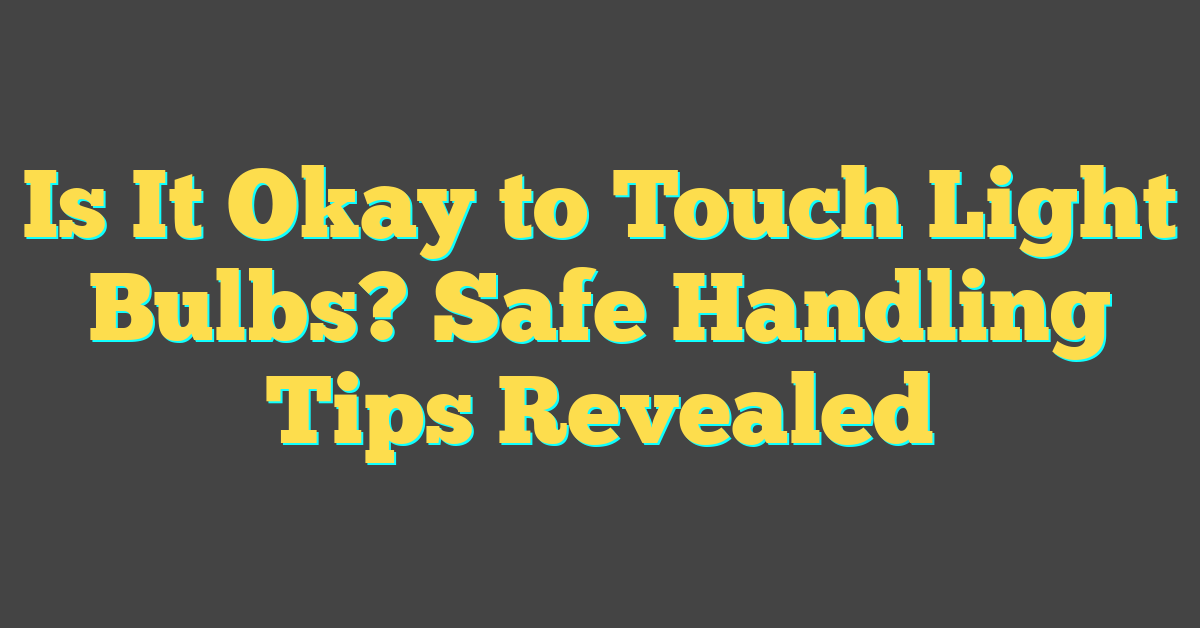Ever found yourself changing a light bulb and wondered if you’re really supposed to grab it with your bare hands? It’s a common question that might flicker across your mind as you reach for that new bulb.

The truth is, touching light bulbs can be a bit of a no-no, but it’s not just about the potential for burns. There’s more to consider, especially with the different types of bulbs out there.
Let’s shed some light on the dos and don’ts of handling light bulbs, so you can keep your fingers safe and your rooms well-lit without any hiccups.
Why touching light bulbs can be a problem
When you’re deep in your DIY project or adjusting the ambiance in your home, handling light bulbs might seem harmless. But there are hidden dangers and pitfalls to consider. Your fingers carry oils and tiny debris, seemingly insignificant, yet they can drastically reduce the lifespan of your bulbs.
Shortened Lifespan of Bulbs
The most immediate problem is the transfer of oils from your skin to the bulb. This oil, often invisible to the naked eye, heats up faster than the rest of the glass when the bulb is on. Over time, these hotspots can lead to:
- Premature dimming
- Unexpected color changes
- Potential bulb failure
Incandescent and halogen bulbs are particularly susceptible due to the high operating temperatures. But LEDs aren’t immune; even though they run cooler, contaminants can still affect the LED’s luminescent layer.
Potential Hazards
Beyond bulb life, safety is a paramount concern. Touching a bulb without proper gauge can be risky, especially if it’s been on for a while. The heat from an active bulb can cause serious burns. Always ensure a bulb has sufficient time to cool down before attempting to change or adjust it.
Checklist for Safe Handling:
- Turn off the power and let the bulb cool
- Use a clean, dry cloth or gloves for grip
- Handle by the base when possible
Maintaining Bulb Performance
To keep those lights shining bright and avoid hiccups in your lighting atmosphere, follow the guidance above. It’s not just about avoiding a sputter or pop after flipping the switch; it’s about guaranteeing that each fixture in your home performs optimally for as long as possible. Remember, the less you touch the glass, the happier your bulbs—and by extension, you—will be.
Different types of light bulbs and their sensitivity

Light bulbs aren’t all created equal. You’ve probably encountered a variety of bulb types with different sensitivities to touch. It’s worth knowing which ones are more forgiving and which are not.
Incandescent bulbs, your old-school, classic light bulbs, are the least tolerant to the oils from skin contact. These bulbs work by heating a thin wire filament to a temperature that produces light, which means the glass can get extremely hot, and any residue could potentially shorten the lifespan or even lead to the bulb bursting. When you’re handling these bulbs for your DIY lighting project, don’t forget to give them time to cool down and use a cloth for grip.
Halogen bulbs are similar to incandescent in operation but they burn hotter, meaning even a small amount of oil can cause a hotspot, leading to bulb failure. Given their high operating temperature and sensitivity, it’s critical to handle them with care.
Compact Fluorescent Lamps (CFLs) come in next. Though not as sensitive as their incandescent and halogen counterparts, the spiral tubes of CFLs can still accumulate unwanted grease and dust. The main issue isn’t just about touching them, but ensuring they’re free of contaminants that could affect their performance.
LEDs are the most robust when it comes to handling. These bulbs don’t get as hot and aren’t affected as much by skin oils. However, they have electronic components that could be sensitive to static electricity from your fingers which means even LEDs appreciate a gentle, clean-handed approach.
| Type | Sensitivity to Touch | Handling Caution |
|---|---|---|
| Incandescent | High | Use cloth |
| Halogen | High | Use cloth |
| CFL | Medium | Clean hands |
| LED | Low | Avoid static |
The danger of burns from touching hot bulbs

« What is the Safest Type of Light Bulb? Unveiling the Healthiest Choice for Your Home
Why Light Bulbs Don’t Last: Uncover the Surprising Reasons & Solutions »
Touching a hot light bulb can result in serious burns, which is a risk often overlooked in the hustle of completing a home DIY project. It’s imperative that you’re aware of the heat emitted by different types of bulbs and the potential for injury.
Incandescent and Halogen Bulbs
Both incandescent and halogen bulbs operate at much higher temperatures compared to their CFL and LED counterparts. In fact, they can reach temperatures hot enough to cook an egg!
- Incandescent bulbs may climb as high as 200 to 250 degrees Fahrenheit.
- Halogen bulbs can soar even further, up to 300 degrees Fahrenheit or more.
If you accidentally graze one of these bulbs with your hand, you could sustain a burn that might not only ruin your day but also could require medical attention.
CFLs and LEDs: Lower Risk but Still Caution Needed
CFL bulbs run cooler than incandescent and halogen bulbs but can still get sufficiently hot to cause discomfort or a minor burn. LEDs, while being the coolest operating bulbs, can still pose a burn risk after extended use, mainly to sensitive skin or when touched by curious children.
Here’s a quick look at the temperatures you could potentially be dealing with:
| Bulb Type | Standard Operating Temperature |
|---|---|
| Incandescent | 200-250°F |
| Halogen | 300°F or higher |
| CFL | 100-150°F |
| LED | 80-100°F |
Always allow bulbs to cool down before handling them, especially if you’ve had them switched on for an extended period. When working with lighting, it’s a smart move to cut the power and let the bulb return to room temperature.
Safe Handling Practices
When replacing or cleaning light bulbs:
- Cut the power to avoid electrical risk.
- Use a cloth or gloves to handle bulbs that may have been on recently.
- Allow adequate time for the bulbs to cool.
- Never attempt to remove a bulb that’s in operation.
Remember, your safety is paramount, and it’s always better to wait a few minutes than to rush and risk a painful burn. Keep the above tips in mind the next time you’re swapping out a bulb, and you’ll avoid a common pitfall many enthusiasm DIYers encounter.
The risk of damaging the bulb by touching it

When handling light bulbs, you might not only be putting yourself at risk of burns, but you could also damage the bulb itself. This is particularly true for certain types of bulbs where touching them can lead to a shorter lifespan or immediate malfunction. As a home DIY enthusiast with a passion for lighting, you know the importance of preserving the integrity of your light bulbs.
Halogen bulbs, for instance, are very sensitive to the oils found on human skin. The oil from your fingertips can cause a hotspot on the glass when the bulb is turned on, leading to weakening of the glass and potentially causing the bulb to failure or even shatter. Similarly, high intensity discharge (HID) bulbs used in some projectors and car headlights are also at risk when touched, as the contaminants can result in an uneven light output or premature burnout.
Even though CFL and LED bulbs aren’t as sensitive to skin oils, they still have components that are susceptible to the effects of handling. The base of a CFL bulb, which contains the electronics that power the light, can be compromised if it’s handled roughly. And with LEDs, although they remain cooler to the touch, they contain sensitive electronic components that can be damaged by static electricity from your hands.
To maintain the integrity and performance of your light bulbs, follow these precautions:
- Always hold the bulb by its base, avoiding contact with the glass.
- If you must handle the glass portion, wear clean, soft gloves to minimize the transferring of body oils and static electricity.
- For sensitive bulbs like halogen and HID, using a clean, dry cloth or a tissue can also provide a protective barrier.
- Avoid shaking or rough handling, as this can damage the fragile inner components, especially for CFLs and LEDs.
Remember these guidelines next time you’re swapping out a bulb or working on a home lighting project. By treating your light bulbs with care, you’re not just preventing potential harms to yourself, but also ensuring that your lights continue to shine brightly and efficiently for the foreseeable future.
How to safely handle light bulbs

When it’s time to replace or install a light bulb, knowing the correct way to handle them can save you from unexpected hazards. Safety first is more than just a saying; it’s a necessity in preventing accidents and extending the life of your light bulbs.
Firstly, ensure your hands are clean and dry before touching a light bulb. This is especially important for halogen and HID bulbs as they’re quite sensitive to skin oils. If you’re replacing a bulb that’s been used recently, wait a few moments for it to cool down to avoid the risk of burns.
For those hard-to-reach fixtures, it’s handy to have a sturdy step stool or ladder to maintain your balance. Always turn off the electrical supply before you start. It’s nothing short of a best practice to prevent electrical shocks.
Using a soft cloth or gloves can add a layer of protection between your skin and the bulb. This method is particularly effective in reducing the amount of oil transferred to the bulb’s surface, which is paramount for preserving both the bulb’s integrity and your safety.
Be mindful of how you handle the bulb:
- Grasp it by the base, not the glass.
- Avoid unnecessary pressure, as squeezing too hard can cause the bulb to crack.
- Screw and unscrew the bulb gently from the socket.
Damaging the bulb’s components isn’t just about the potential waste of money—it also creates a needless risk when operating the light fixture.
Proper disposal of any broken or burnt-out bulbs is essential. LEDs and CFLs contain elements that can be harmful to the environment, so recycling them at a designated facility helps in keeping eco-friendly practices in check.
Remember, each bulb has its own set of handling instructions, so taking a quick moment to review the manufacturer’s guidelines before starting your project can be incredibly insightful.
Conclusion
So there you have it! Next time you’re about to change or clean a bulb remember to take a moment to ensure your hands are clean and dry. If it’s been on, give it time to cool off. And don’t forget, a soft cloth or gloves can be a bulb’s best friend by keeping those oils at bay. Handle them with care by the base and remember that a little gentleness goes a long way. Lastly don’t just toss those old bulbs in the trash—recycle them properly and keep our planet in mind. With these tips you’ll keep your bulbs—and your fingers—in tip-top shape!
Frequently Asked Questions
How should I handle light bulbs to prevent accidents?
Ensure your hands are clean and dry before touching light bulbs. For sensitive types such as halogen or HID bulbs, avoid direct skin contact to reduce the risk of accidents.
Is it okay to touch light bulbs with my bare hands?
It is not ideal to touch especially sensitive bulbs like halogen or HID with bare hands as skin oils can damage the bulb. Use a soft cloth or gloves for these types.
What should I do before handling a used light bulb?
Always wait for the light bulb to cool down completely before handling it to prevent the risk of burns.
Can I hold a light bulb by its glass?
Avoid grasping the glass part of the bulb to minimize pressure which can cause damage. Instead, hold the bulb by its base.
What’s the best way to dispose of broken or burnt-out light bulbs?
Properly dispose of broken or burnt-out bulbs by recycling them at designated facilities to maintain eco-friendly practices.
Why is it important to review the manufacturer’s guidelines for light bulbs?
Manufacturers provide specific handling, usage, and disposal guidelines to ensure safety and optimal performance of their light bulbs. Always reviewing these can help you avoid common mistakes.




